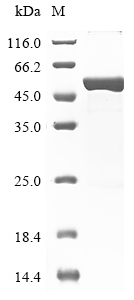Recombinant Human Glial fibrillary acidic protein (GFAP) is produced using an E.coli expression system and contains the complete protein sequence from amino acids 1 to 432. The protein carries an N-terminal 6xHis-tag that simplifies purification and detection processes. SDS-PAGE analysis confirms a purity level exceeding 90%, which appears to provide reliable quality for research applications. This product is intended for research use only and is not for diagnostic or therapeutic purposes.
GFAP is a key intermediate filament protein that's predominantly found in astrocytes within the central nervous system. It plays what seems to be a crucial role in maintaining the structural integrity and function of neural cells. The protein is involved in various cellular processes, including cell communication and the modulation of synaptic activity. This makes it particularly significant for studies focused on neurodegenerative diseases and neural development.
Potential Applications
Note: The applications listed below are based on what we know about this protein's biological functions, published research, and experience from experts in the field. However, we haven't fully tested all of these applications ourselves yet. We'd recommend running some preliminary tests first to make sure they work for your specific research goals.
Based on the provided information, the recombinant Human Glial Fibrillary Acidic Protein (GFAP) is expressed in E. coli, a prokaryotic system that is generally unsuitable for producing properly folded eukaryotic intermediate filament proteins. GFAP requires specific folding, assembly into complex filament structures, and may need post-translational modifications that E. coli cannot provide. The presence of an N-terminal 6xHis tag may further interfere with proper folding and filament formation. While the protein is full-length (1-432aa) with >90% purity, the E. coli expression system significantly increases the risk of misfolding. Since activity is explicitly unverified, the protein cannot be assumed to be correctly folded or bioactive without experimental validation.
1. Antibody Development and Validation
This application is appropriate. The recombinant GFAP can serve as an effective immunogen for antibody generation, as antibodies may recognize linear epitopes even if the protein is misfolded. The His tag facilitates purification and screening. However, antibodies may not recognize conformational epitopes of native GFAP in astrocytes if the protein is misfolded. Validation against native GFAP from mammalian sources is recommended.
2. Protein-Protein Interaction Studies
This application requires caution. The His tag enables technical feasibility for pull-down assays, but if GFAP is misfolded, interactions may not be physiological. The protein may not properly interact with authentic binding partners in intermediate filament networks. This application should only be pursued after confirming proper folding through biophysical characterization.
3. Biochemical Characterization and Stability Studies
This application is well-suited and should be prioritized. Techniques like circular dichroism spectroscopy, dynamic light scattering, and thermal stability assays can directly assess the protein's folding state and stability. These studies are valuable even if the protein is misfolded, as they characterize the recombinant product itself.
4. In Vitro Filament Assembly Assays
This application is highly dependent on correct folding. If GFAP is misfolded, it will not assemble into proper intermediate filaments, leading to misleading results about assembly mechanisms. This application requires prior validation of proper folding and assembly capability through electron microscopy or other structural analyses.
Final Recommendation & Action Plan
Given the high probability of misfolding in E. coli for this complex eukaryotic protein, we recommend first performing a comprehensive biophysical characterization (e.g., circular dichroism for secondary structure, size-exclusion chromatography for oligomeric state) to assess folding quality. Antibody development can proceed immediately, while protein interaction and filament assembly studies should be deferred until proper folding is validated. For filament assembly assays, include positive controls with native GFAP when possible. If misfolding is detected, focus applications on biochemical characterization and antibody development rather than functional studies. Consider using eukaryotic expression systems for research requiring properly folded GFAP with native functionality.






